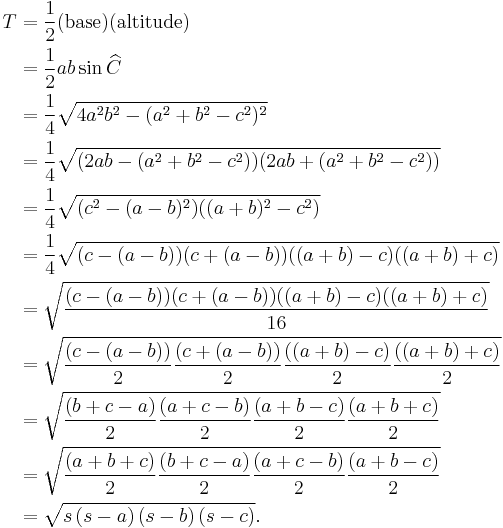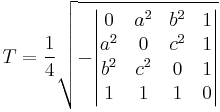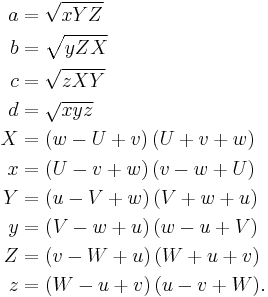Heron's formula
In geometry, Heron's (or Hero's) formula, named after Heron of Alexandria, states that the area T of a triangle whose sides have lengths a, b, and c is
where s is the semiperimeter of the triangle:
Heron's formula can also be written as:
Heron's formula is distinguished from other formulas for the area of a triangle, such as half the base times the height or half the modulus of a cross product of two sides, by requiring no arbitrary choice of side as base or vertex as origin.
Contents |
History
The formula is credited to Heron (or Hero) of Alexandria, and a proof can be found in his book, Metrica, written c. A.D. 60. It has been suggested that Archimedes knew the formula, and since Metrica is a collection of the mathematical knowledge available in the ancient world, it is possible that it predates the reference given in the work.[1]
A formula equivalent to Heron's namely:
 , where
, where 
was discovered by the Chinese independently of the Greeks. It was published in Shushu Jiuzhang (“Mathematical Treatise in Nine Sections”), written by Qin Jiushao and published in A.D. 1247.
Proof
A modern proof, which uses algebra and is quite unlike the one provided by Heron (in his book Metrica), follows. Let a, b, c be the sides of the triangle and A, B, C the angles opposite those sides. We have
by the law of cosines. From this proof get the algebraic statement:
The altitude of the triangle on base a has length b·sin(C), and it follows
The difference of two squares factorization was used in two different steps.
Proof using the Pythagorean theorem
Heron's original proof made use of cyclic quadrilaterals, while other arguments appeal to trigonometry as above, or to the incenter and one excircle of the triangle [2]. The following argument reduces Heron's formula directly to the Pythagorean theorem using only elementary means.
In the form 4T 2 = 4s(s − a)(s − b)(s − c), Heron's formula reduces on the left to (ch)2, or
 which is the same as
which is the same as 
using b 2 − d 2 = h 2 by the Pythagorean theorem, and on the right to
via the identity (p + q) 2 − (p − q) 2 = 4pq. It therefore suffices to show
and
Then expanding the former you get the following:
and that reduces to  by substituting 2s = (a + b + c) and simplifying. Submitting for s the latter s(s − a) − (s − b)(s − c) reduces only as far as (b 2 + c 2 − a 2)/2. But if we replace b 2 by d 2 + h 2 and a 2 by (c − d) 2 + h 2, both by Pythagoras, simplification then produces cd as required.
by substituting 2s = (a + b + c) and simplifying. Submitting for s the latter s(s − a) − (s − b)(s − c) reduces only as far as (b 2 + c 2 − a 2)/2. But if we replace b 2 by d 2 + h 2 and a 2 by (c − d) 2 + h 2, both by Pythagoras, simplification then produces cd as required.
Numerical Stability
Heron's formula as given above is numerically unstable for triangles with a very small angle. A stable alternative involves arranging the lengths of the sides so that  and computing
and computing
The brackets in the above formula are required in order to prevent numerical instability in the evaluation.
Generalizations
Heron's formula is a special case of Brahmagupta's formula for the area of a cyclic quadrilateral. Heron's formula and Brahmagupta's formula are both special cases of Bretschneider's formula for the area of a quadrilateral. Heron's formula can be obtained from Brahmagupta's formula or Bretschneider's formula by setting one of the sides of the quadrilateral to zero.
Heron's formula is also a special case of the formula of the area of the trapezoid based only on its sides. Heron's formula is obtained by setting the smaller parallel side to zero.
Expressing Heron's formula with a Cayley–Menger determinant in terms of the squares of the distances between the three given vertices,
illustrates its similarity to Tartaglia's formula for the volume of a three-simplex.
Another generalization of Heron's formula to pentagons and hexagons inscribed in a circle was discovered by David P. Robbins.[2]
Heron-type formula for the volume of a tetrahedron
If U, V, W, u, v, w are lengths of edges of the tetrahedron (first three form a triangle; u opposite to U and so on), then[3]
where
See also
Notes
- ^ Weisstein, Eric W., "Heron's Formula" from MathWorld.
- ^ D. P. Robbins, "Areas of Polygons Inscribed in a Circle", Discr. Comput. Geom. 12, 223-236, 1994.
- ^ W. Kahan, "What has the Volume of a Tetrahedron to do with Computer Programming Languages?", [1], pp. 16-17.
References
- Heath, Thomas L. (1921). A History of Greek Mathematics (Vol II). Oxford University Press. pp. 321–323.















